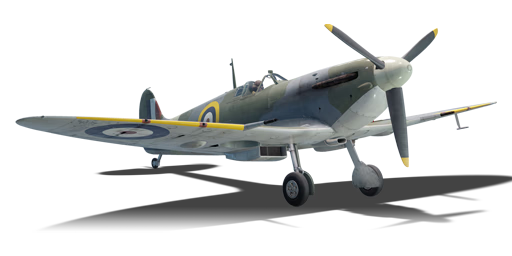



In 1939, a trial was undertaken in which a Spitfire Mk I was fitted with a new 1,175-hp Merlin XII engine, the success of which resulted in the designation of a new variant: the Spitfire Mk II. Other improvements included a new, more efficient cooling system, and a move away from the previous external electric engine starting systems. The Mk IIb variant in particular was fitted with the "B-type" wing, a modification of the A-type wing of the Mk Ia and Mk IIa replacing the inner .303 machine guns with 20 mm Hispano cannons. Spitfire Mk IIs were rapidly manufactured and delivered, replacing all Mk Is in active service by April 1941.
The Spitfire Mk IIb has been in the game since the start of the Open Beta Test. With the introduction of the 20 mm Hispano cannons, the Mk IIb resolves the flaws of the preceding Mk IIa, namely the weak armaments, while retaining all of its other characteristics. However, this also comes with an increase in battle rating, meaning that its previous advantages in climb rate and speed against common opponents, while still adequate, are no longer as prominent. Turn-fighting becomes even more important against the sheer speed and power of German and American fighters. While the increased power of the cannons will be helpful in taking down opponents once a firing solution is achieved, trigger discipline is advised in order to preserve ammunition for those crucial moments.
flaps
flaps
flaps
brake
| Belt | Belt filling | Armor penetration (mm) at a distance: | |||||
|---|---|---|---|---|---|---|---|
| 10 m | 100 m | 500 m | 1000 m | 1500 m | 2000 m | ||
| HEI/SAP-I/T | 22 | 20 | 14 | 9 | 6 | 4 | |
| AP-T/HEI/SAP-I | 37 | 35 | 25 | 16 | 10 | 7 | |
| AP-T/T/HEI | 37 | 35 | 25 | 16 | 10 | 7 | |
| AP-T/SAP-I/HEI/AP-T | 37 | 35 | 25 | 16 | 10 | 7 | |
| HEI/HEI/SAP-I | 22 | 20 | 14 | 9 | 6 | 4 | |
| Belt | Belt filling | Armor penetration (mm) at a distance: | |||||
|---|---|---|---|---|---|---|---|
| 10 m | 100 m | 500 m | 1000 m | 1500 m | 2000 m | ||
| T/AP/AP-I/Ball/Ball/I | 13 | 12 | 7 | 3 | 2 | 0 | |
| T/AP/AP-I/AP-I/I | 13 | 12 | 7 | 3 | 2 | 0 | |
| IT/AP-I | 13 | 12 | 7 | 3 | 2 | 0 | |
| AP-I/AP-I/I | 13 | 12 | 7 | 3 | 2 | 0 | |












Flight performance | |
|---|---|
Survivability |
|---|
Weaponry |
|---|